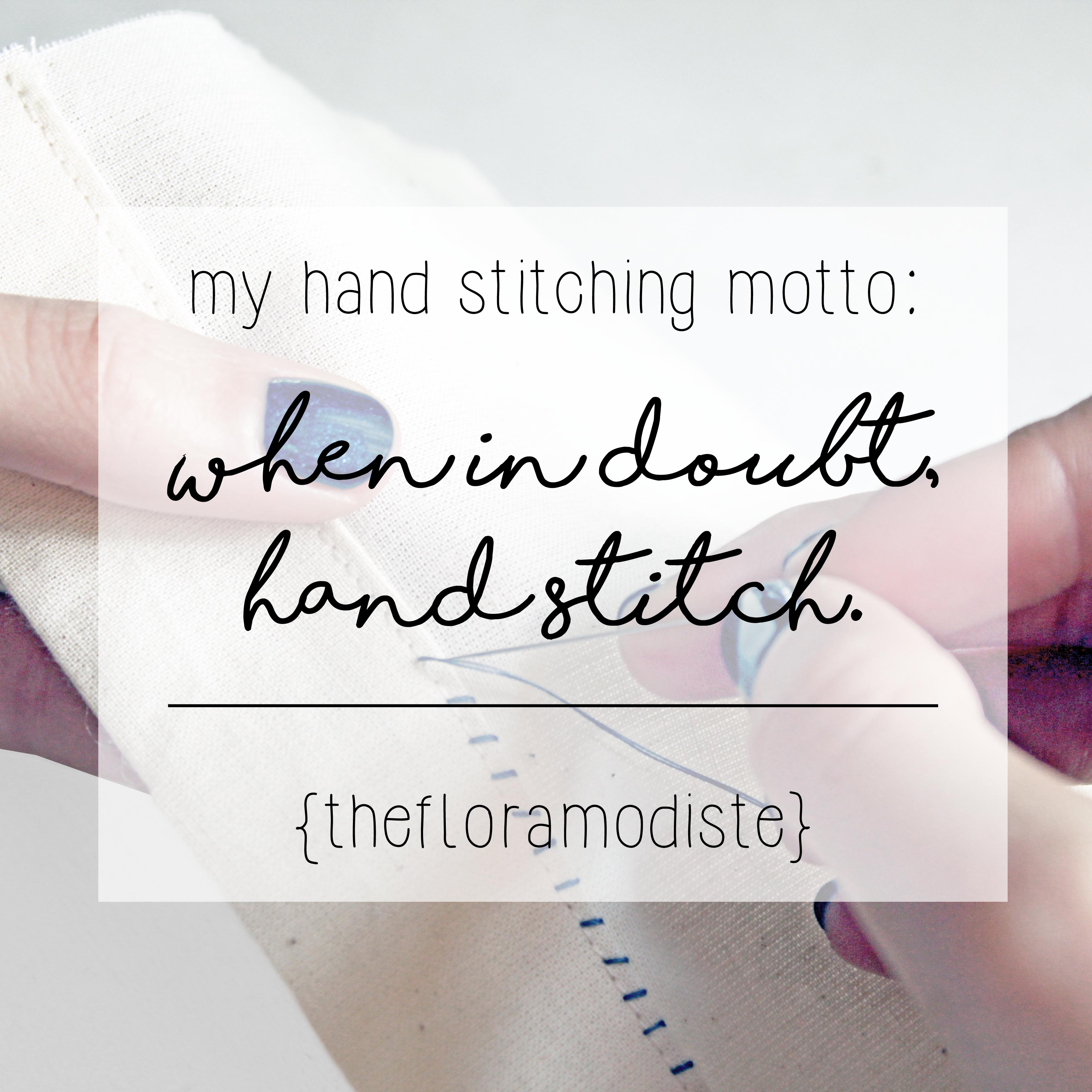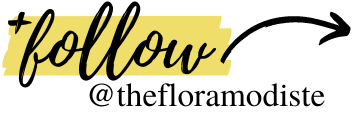How To Sew 3 Different Types Of Hand Stitches, Part Two

Last year, one of our very first posts here on The Flora Modiste was all about how important hand stitching is. And in that post, I showed you how to sew 5 commonly used hand stitches. This post is going to show you how to sew three additional different types of hand stitches, step by step.
And in case you forgot.. I seriously LOVE hand stitching. I could sit for hours just hand stitching a project.. It keeps my hands busy, buy my mind is free to wander.
And since I'm one of those people that ALWAYS has to be doing something, hand stitching is the perfect way to keep me productive, occupied, and honing a skill. All at the same time! I also have a sort of motto when it comes to hand stitching:

To me, this means that if you aren't sure how to do something or how to finish up a project.. Hand stitch it.
For example: If you aren't sure how to finish off a zipper, hand stitch it. (I actually did that with my Teri Dress sewing tutorial.. And I ended up loving that method for finishing off an invisible zipper.)
If you aren't sure how to finish off a hem, hand stitch it. If you aren't sure how to sew up a buttonhole with your machine, hand stitch it.

(This post is part two of two in our series on how to sew different types of hand stitches. So make sure to download our complete hand stitching tutorial below that walks you through how to sew a total of EIGHT unique hand stitches!) Nine times out of ten, hand stitching part of a project is going to give you a better result than just doing guesswork with a machine. (That NEVER ends well, IMHO.)
Nine times out of ten, hand stitching part of a project is going to give you a better result than just doing guesswork with a machine. (That NEVER ends well, IMHO.)
There is a reason that high quality garments often have elements of hand stitching.. Yes, it takes more time, but it also looks SO much better. Now, I'm not saying to go off and hand stitch everything for every project.
I'm saying that if you incorporate more hand sewing into your sewing projects, you will see the quality difference. If you make it a goal to hand stitch at least one element in each project, it will challenge you in a new way.

You could even take that a step further and try different types of hand stitches with every project.. Which is where this tutorial comes in. In this post, I will be showing you how to hand stitch the following:
- The Blanket Stitch
- The Whipstitch
- The Overcasting Stitch

These stitches are a bit more advanced than those I covered in part one of this series. But they can also be extremely helpful for the seamstress that does not yet own a serger. (BTW, I didn't own a serger until just about a year ago. And I got along just fine without it for about 10 years.)
Most sewing machines these days tend to have a stitch that imitates a serger stitch, but I know that not all of them do. And if you happen to be one of those ladies that doesn't own either a serger or have an imitation serger stitch on your sewing machine.. Then this tutorial is going to be perfect for you!
Knowing these different types of hand stitches will also be helpful for those pesky places that a serger can't reach, or for more delicate fabrics that can't handle said serger. So, let's get started, shall we?
(This post is part two of two in our series on how to sew different types of hand stitches. So make sure to download our complete hand stitching tutorial below that walks you through how to sew a total of EIGHT unique hand stitches!)
How to sew different types of hand stitches: #1. The Blanket Stitch

The blanket stitch is most often used to finish off the raw edge of a seam, and gives it a bit of a more decorative look. This stitch can also be used to cover hooks and eyes or any unwanted thread chains that may be hanging about.
I think that this stitch is a great alternative to using a serger as well. It definitely takes more time than just serging a seam..




First, make sure to backstitch before beginning your stitch. (Not sure what a backstitch is? I covered how to sew a backstitch in part one of this hand stitching series.)
Push the needle to the back side of the fabric. Bring the needle back to the right side of the fabric, making a giant loop above your raw seam.
Reinsert the needle in the fabric, about 1/8" away from the previous point. Push the needle towards the back side of the fabric, making sure the needle is pulled out INSIDE (not behind) the thread loop. And repeat!
NOTE: Be careful not to pull the stitches too tight. If you pull too tight, it will roll the fabric edge, which we don't want. You are going for nice, easy arches that aren't too tight, but aren't too loose either. Life's all about balance.
(This post is part two of two in our series on how to sew different types of hand stitches. So make sure to download our complete hand stitching tutorial below that walks you through how to sew a total of EIGHT unique hand stitches!)
How to sew different types of hand stitches: #2. The Whipstitch

The whipstitch is almost like a jack-of-all-trades hand stitch. It can be used for both stitching seams together as well as for hemming.
In a pinch it can be used in lieu of a serger, but there are definitely better options that can be used. (i.e. What we just went over above, the blanket stitch.)
The whipstitch can also be used for adding in lace or appliqué inserts, and for joining folded ends together when sewing ties and bands.

Which makes it such a handy little stitch to learn.


Before starting, make sure to backstitch. Push the needle to the back side of the fabric.
Move the needle 1/8" up and to the left, and push back to the right side of the fabric, and 1/8" down and to the left. Repeat!
NOTE: The stitch holds best when done at a bit of a diagonal, but only just. If trying to use this stitch in place of a serger, just keep your stitches closer together, so that no loose threads escape.
(This post is part two of two in our series on how to sew different types of hand stitches. So make sure to download our complete hand stitching tutorial below that walks you through how to sew a total of EIGHT unique hand stitches!)
How to sew different types of hand stitches: #3. The Overcasting Stitch

The overcasting stitch is most often used for finishing a raw edge, to help prevent the fabric from unraveling. Again, a perfect option to use in lieu of a serger or a serger-like stitch.
Out of all three stitches in this tutorial, this is probably the best option to use when trying to imitate a serger stitch and seam closure.

Rather than just stitching one row of whipstitches, the overcasting stitch goes back over the original stitches, to create an even stronger finish.
This is especially helpful for fabric that needs some extra reinforcement, or fabric that unravels extremely easily.



To start, make sure to backstitch. Follow the same steps as with the whipstitch: Push the needle to the back side of the fabric.
Move the needle 1/8" up and to the left, and push back to the right side of the fabric, 1/8" down and to the left.
Follow this stitch all the way to the end of the seam.. And then when you get there, go back over what you just stitched, using the same method. Make sure you insert the needle into the same spots as before, so that all is even.
When you finish, you should have little V's all along your (no longer raw) seam.

I hope that learning these different types of hand stitches will encourage you to hone your hand sewing skills, and to try something new.

And please.. Please don't leave raw, unfinished edges in your projects. It's so easy to just close up those raw edges using these stitches. You don't have to go out and buy a serger--Just some good hand sewing needles!
And the thing with hand sewing is that when you get used to the motions of it, you can only get better. And faster. I don't even have to think when I'm hand sewing anymore.. I can just put on an episode of It's Always Sunny and get to work.
Do you have any hand stitches you would love to learn how to work with? Let me know below!
(This post is part two of two in our series on how to sew different types of hand stitches. So make sure to download our complete hand stitching tutorial below that walks you through how to sew a total of EIGHT unique hand stitches!) 






